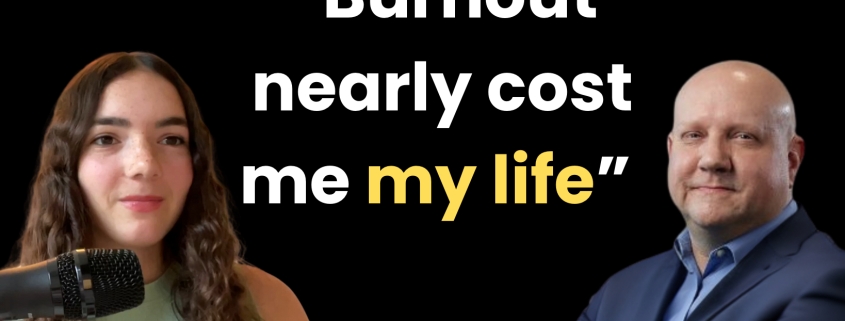CEO Shares the Shocking Truth About Work Life Balance (It’s Not What You Think)
In today’s fast-paced work environment, burnout has become an increasingly prevalent issue affecting employees across all industries. The COVID-19 pandemic has further exacerbated this problem, leading to what experts call “The Great Resignation.” To shed light on these critical issues and provide valuable insights, we sat down with Michael Levitt, a renowned burnout prevention expert, keynote speaker, and host of the Breakfast Leadership podcast.
In this comprehensive article, we’ll explore Michael’s personal journey with burnout, discuss strategies for preventing and combating burnout, examine the factors driving workplace culture changes, and provide actionable advice for both employees and leaders to create healthier, more productive work environments.
Michael Levitt’s Burnout Story: A Wake-Up Call
Michael’s expertise in burnout prevention stems from his personal experience with severe burnout, which led to a series of life-altering events. In 2007, Michael was hired as a healthcare executive for a startup clinic, despite having no healthcare experience. His extensive background in startups made him an ideal candidate for navigating the challenges of launching a new business.
However, Michael’s dedication to the job came at a significant personal cost. He shares, “I made a huge mistake when I was launching the business. Even though I was an employee, I treated it as if it was my own company, which is not necessarily a bad thing per se, but I didn’t have any boundaries around when I worked and when I didn’t.”
For two solid years, Michael worked from 6 am to 11 pm, seven days a week. This grueling schedule led to neglect of his physical health, with no exercise, poor eating habits, and a complete lack of leisure activities. The consequences of this lifestyle became apparent in May 2009 when Michael suffered a heart attack that should have killed him.
The aftermath of his heart attack was equally challenging. Seventeen weeks later, during the Great Recession, Michael lost his job in an area heavily impacted by the economic downturn. The subsequent months brought a cascade of personal and financial difficulties, including:
1. Relocating to a new city for work
2. Commuting long distances while separated from family
3. Losing the family car due to inability to make payments
4. Facing home foreclosure
Michael reflects on this period, saying, “In a year’s time, I had a heart attack that should have killed me. I lost my job. I lost my car. I lost my home. And all those things happened to me because I was burned out.”
Recognizing Burnout: More Than Just Stress
One of the critical aspects of preventing burnout is being able to differentiate between normal stress and the early signs of burnout. Michael explains that while stress is a normal part of life and can even be motivating, burnout is characterized by prolonged, unaddressed stress.
The World Health Organization defines burnout as a “workplace phenomenon caused by unaddressed and prolonged stress.” Michael emphasizes that when stress builds up over time without being addressed, it can lead to burnout.
Some key signs that you may be approaching burnout include:
1. Poor sleep quality
2. Increased irritability or anger
3. Neglecting activities you once enjoyed
4. Physical symptoms such as headaches or muscle tension
5. Decreased productivity and focus
It’s crucial to pay attention to these signs and take action before reaching a critical point of burnout.
Immediate Steps to Combat Burnout
If you recognize signs of burnout in yourself or others, there are several immediate steps you can take to address the issue:
1. Examine your sleep habits: Quality sleep is crucial for mental and physical recovery. Invest in comfortable bedding and create a sleep-friendly environment.
2. Set clear boundaries: Establish clear start and end times for your workday, especially when working remotely.
3. Prioritize leisure activities: Make time for hobbies and activities you enjoy, even if it’s just for short periods.
4. Practice mindfulness: Incorporate mindfulness techniques or meditation into your daily routine to manage stress.
5. Seek support: Reach out to colleagues, friends, or professionals if you’re struggling to cope with stress.
Michael emphasizes that for most people, completely reinventing their lives isn’t necessary. Often, small adjustments can make a significant difference in preventing burnout.
The Great Resignation: Understanding the Shift in Workplace Culture
The COVID-19 pandemic has dramatically altered the landscape of work, leading to what has been termed “The Great Resignation.” Michael provides insights into the factors driving this phenomenon:
1. Reflection on work-life balance: The pandemic forced many people to reassess their priorities and the role of work in their lives.
2. Increased autonomy: Remote work allowed employees to experience greater flexibility and control over their work environment.
3. Realization of alternative work models: Many discovered that traditional office-based work wasn’t the only effective way to be productive.
4. Desire for better management: Employees became less tolerant of poor management practices, especially micromanagement.
5. Shift in values: There’s been a growing emphasis on work-life integration and personal well-being.
Michael notes, “A lot of people realized what work was for them and how it wasn’t working for them.” This realization has led many to seek out new opportunities that better align with their values and desired lifestyle.
Creating a Workplace Culture That Retains Talent
In light of the Great Resignation, organizations need to focus on creating workplace cultures that not only attract but also retain top talent. Michael shares several key strategies:
1. Emphasize trust and autonomy: Allow employees the freedom to manage their work in ways that suit them best.
2. Provide flexibility: Offer options for remote or hybrid work when possible.
3. Focus on results, not hours worked: Judge employees based on their output and achievements rather than time spent at a desk.
4. Invest in employee development: Provide opportunities for growth and learning within the organization.
5. Encourage open communication: Create channels for employees to share feedback and concerns without fear of reprisal.
6. Recognize and reward good work: Implement systems to acknowledge and appreciate employee contributions.
Michael shares an anecdote from his own career that illustrates the power of trust and autonomy: “I remember my first day, my boss, his name is Rick, came up to me at 3:32, and this was in Chicago, was 3:32 PM Central Time. And it was my first day there. And he came to my cubicle. He leaned in and says, ‘Okay, I’m just gonna lay down the ground rules, what it’s gonna be for you to work here.’ And I’m thinking, okay, here we go. He’s gonna be managing me, micromanaging me, not letting me do anything on my own or anything like that. He looks at me, he goes, ‘I don’t care when you get here, I don’t care when you go home. As long as you get your work done, everything’s good.'”
This approach to management, focused on results rather than rigid schedules, can significantly improve employee satisfaction and retention.
Common Mistakes Managers Make
Even well-intentioned managers can make mistakes that contribute to employee burnout and dissatisfaction. Michael highlights some common pitfalls:
1. Micromanagement: Constantly monitoring and controlling employees’ work can lead to stress and reduced productivity.
2. Lack of empathy: Failing to understand and acknowledge employees’ personal circumstances and challenges.
3. Poor communication: Not providing clear expectations or feedback on performance.
4. Neglecting employee development: Failing to provide opportunities for growth and skill-building.
5. Ignoring work-life balance: Expecting employees to be available 24/7 or regularly work long hours.
6. One-size-fits-all approach: Not recognizing that different employees may have different needs and working styles.
Michael emphasizes the importance of understanding individual employees’ needs and working styles. He suggests that managers should work with their team members to design ideal workdays that maximize productivity while respecting personal preferences and circumstances.
Setting Boundaries in Remote Work
The shift to remote work has brought many benefits but also new challenges, particularly when it comes to maintaining a healthy work-life balance. Michael offers several strategies for setting boundaries when working from home:
1. Establish a dedicated workspace: If possible, create a separate area for work to help mentally separate professional and personal time.
2. Set clear working hours: Communicate your availability to colleagues and stick to your schedule as much as possible.
3. Take regular breaks: Schedule short breaks throughout the day to avoid burnout and maintain productivity.
4. Use technology mindfully: Turn off work-related notifications outside of working hours.
5. Create transition rituals: Develop routines that signal the start and end of your workday, such as a short walk or changing clothes.
6. Communicate boundaries clearly: Let colleagues and supervisors know your working hours and when you’re not available.
Michael stresses the importance of understanding your own productivity rhythms and designing your workday accordingly. He notes that some people may be most productive in the evening, while others work best early in the morning. The key is to find a schedule that works for you and communicate it clearly with your team.
Leadership Challenges in Executive Coaching
As an executive coach, Michael has observed several common challenges faced by leaders in today’s rapidly changing work environment:
1. Overwhelm: Many leaders try to do too much, often driven by pressure from boards of directors or shareholders.
2. Poor delegation: Some leaders struggle to effectively delegate tasks, leading to personal burnout and stunted team growth.
3. Communication gaps: Misalignment between leadership and board expectations can lead to stress and inefficiency.
4. Lack of prioritization: Trying to focus on too many priorities simultaneously can result in subpar performance across the board.
5. Personal well-being neglect: Leaders often prioritize work at the expense of their own health and well-being.
To address these challenges, Michael recommends that leaders:
1. Focus on no more than two key priorities at a time
2. Improve delegation skills to empower team members
3. Enhance communication with boards and stakeholders
4. Prioritize personal well-being to maintain peak performance
Michael emphasizes, “When you are your best, then you see things, you have more clarity, you can do things better. You just are a better human being and a better employee, a better leader, a better family member, better friend, you name it.”
Advice for Long-Term Success Without Sacrificing Health
Drawing from his experience and expertise, Michael offers several key pieces of advice for achieving long-term success while maintaining health and well-being:
1. Invest in quality sleep: Prioritize good sleep hygiene and invest in comfortable bedding. As Michael puts it, “Spend the money on your bedding because you spend, if you get eight hours of sleep, you’re in that bed for eight hours. That’s a third of your day. So why not make it awesome?”
2. Schedule enjoyable activities: Make time for hobbies and leisure activities, and actually put them in your calendar. “As silly as it sounds, like, okay, I’m going to the nightclub Thursday night, or I’m going to this concert on Wednesday at St. Andy’s Hall or whatever, and you put it on there. Literally put it on there, because what gets scheduled gets done.”
3. Focus on nutrition: Find the foods that give you natural energy and make you feel your best. Consider trying meal delivery services to explore new, healthy options.
4. Self-reflection: Take time to understand what truly motivates and fulfills you. “You gotta figure out what makes you tick. You gotta do a deep dive, and I think a lot of people are scared of doing that. They’re scared of looking within because they’re afraid of what they’re gonna see. Don’t be, don’t be afraid. It’s you.”
5. Continuous learning: Stay curious and open to new ideas and approaches in both your personal and professional life.
6. Build a support network: Cultivate relationships with mentors, peers, and friends who can offer guidance and support.
Michael emphasizes that these strategies can help individuals keep stress at bay and prevent burnout while pursuing their goals and ambitions.
The Future of Work: Embracing Change and Prioritizing Well-being
As we look to the future of work, it’s clear that the landscape is continuing to evolve. The pandemic has accelerated many changes that were already underway, from the adoption of remote work to a greater emphasis on employee well-being. Michael’s insights suggest several key trends that are likely to shape the future of work:
1. Flexibility as a standard: Companies that offer flexible working arrangements are likely to have an edge in attracting and retaining talent.
2. Focus on outcomes: There will be a continued shift away from measuring hours worked to evaluating the quality and impact of work produced.
3. Emphasis on well-being: Organizations will increasingly recognize the link between employee well-being and productivity, leading to more robust wellness programs and policies.
4. Continuous learning: With the rapid pace of technological change, there will be a growing emphasis on continuous skill development and learning.
5. Purpose-driven work: Employees, especially younger generations, will seek out organizations that align with their values and offer meaningful work.
6. Human-centric leadership: There will be a greater demand for leaders who can demonstrate empathy, emotional intelligence, and adaptability.
Creating a Burnout-Proof Future
As we navigate the changing world of work, the insights provided by Michael Levitt offer a roadmap for creating healthier, more productive work environments. By recognizing the signs of burnout, implementing strategies to prevent it, and fostering workplace cultures that prioritize employee well-being, we can work towards a future where burnout is the exception rather than the norm.
For individuals, this means taking proactive steps to manage stress, set boundaries, and prioritize personal well-being. For leaders and organizations, it involves creating flexible, supportive work environments that recognize the unique needs and contributions of each employee.
By embracing these principles, we can create a work culture that not only prevents burnout but also fosters innovation, productivity, and personal fulfillment. As Michael’s journey demonstrates, it’s possible to achieve professional success without sacrificing personal health and happiness. The key lies in recognizing the value of balance, setting clear priorities, and continually adapting to the changing needs of both individuals and organizations.
As we move forward, let’s carry these lessons with us, working together to create a future of work that is not just productive, but also sustainable and fulfilling for all.
Connect with Michael:
👉 Connect with Michael Levitt:
📸 Instagram:  / michael.d.levitt
/ michael.d.levitt
💼 LinkedIn:  / bfastleadership
/ bfastleadership
🎥 YouTube: ![]() / @breakfastleadership
/ @breakfastleadership
🐦 Twitter/X:  / bfastleadership
/ bfastleadership
📘 Facebook:  / bfastleadership
/ bfastleadership
🌐 Linktree: https://linktr.ee/michael.d.levitt
📘 Free Burnout Book: https://breakfastleadership.com/burno…
Connect with Vibrant Guide
📷Instagram: https://www.instagram.com/vibrantguide/
🌎Website: https://vibrantguide.com
🎙️Spotify: https://open.spotify.com/show/36eTU0WUYcaDYQAuzRDzBV?si=ocHEGzXJRT27pVZp-1TSsQ
🎧Apple Podcast: https://podcasts.apple.com/us/podcast/vibrant-guide/id1760974613
🎙️YouTube: https://tinyurl.com/yhbz2ewf










Leave a Reply
Want to join the discussion?Feel free to contribute!